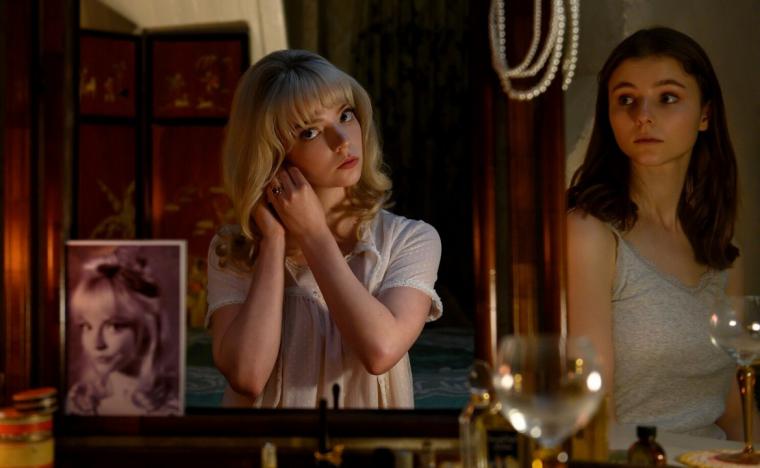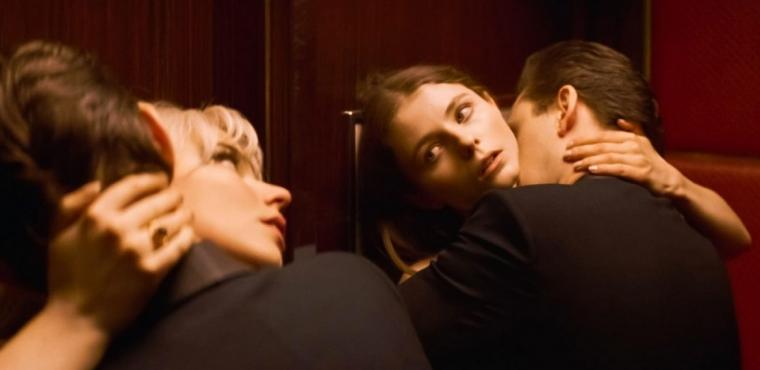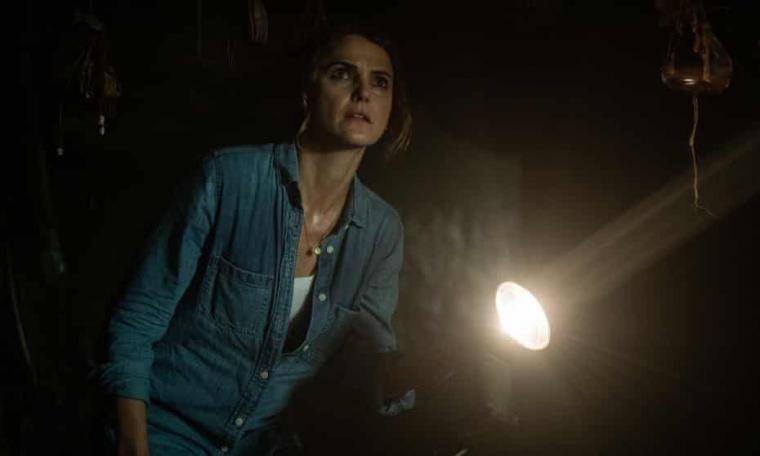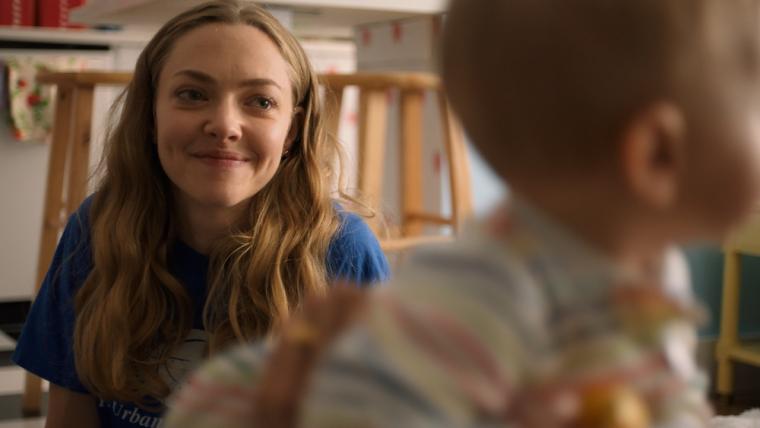
Anya Taylor-Joy and Thomasin McKenzie in Last Night in Soho
LAST NIGHT IN SOHO
As he's already responsible for one of my favorite movies of 2021 (that'd be the music doc The Sparks Brothers), to say nothing of perhaps my all-time-favorite not-guilty guilty pleasure (that'd be 2004's zombie comedy Shaun of the Dead), I suppose I can forgive Edgar Wright for his latest, London-set offering not being my particular cup of Earl Grey. But wow, what a mess Last Night in Soho is. Being a Wright release, it looks terrific and sounds even better, and the writer/director pulls off stunning tricks with mirror imagery that I've literally never seen before. Yet after an appealing opening half-hour, this odd, ultimately unsatisfying blend of time-travel adventure and horror yarn grows more ludicrous and lifeless as it progresses, and by the finale, you can't even recognize it as an Edgar Wright film anymore. While there's a great beat, at least initially, I'll be damned if I could dance to it.
Thomasin McKenzie – an expressive yet traditionally subtle young talent who does a lot of uncharacteristic overplaying here – portrays Eloise Turner, a wannabe fashionista from a small English village who enters her first year of design school in the swinging West End. The girl's obnoxious living conditions and nasty contemporaries, however, prove a bit too swinging for shy, damaged Eloise, and so she retreats, first to a quiet boarding house, and then, in her sleep, to the mid-1960s, where she becomes obsessed with single-gal-about-town Sandie (an ideally cast Anya Taylor-Joy), a radiant bond who longs to be a singing star. All of this, especially the spectacularly recreated '60s production design, is fun stuff, and our attentions are buoyed by the realization that dream-Eloise effectively becomes Sandie, living the hopeful starlet's experiences from within and seeing Sandie's face and body whenever she looks at her reflection – which, luckily for us, is often.
I wish I could adequately describe just how miraculous these effects are – when Sandie travels up or down a nightclub staircase, it's Eloise we see, moving perfectly in-sync, on the mirrored walls – and Wright heightens the pleasure via fantastically swift and canny editing stunts that, given no visible cuts, magically blend our visions of the two women. (On the dance floor with Matt Smith's skeevy “manager” of British ingénues, McKenzie and Taylor-Joy slip so seamlessly in and out of the man's arms that it's almost like witnessing a ménage à trois.) Even though, unlike the rest of Wright's oeuvre, very little of Last Night in Soho is meant to be funny, his stylistic audaciousness had me grinning throughout most of the movie's first third. Cinephiles and Anglophiles alike, meanwhile, can't help but be tickled by the casting of two British legends whose film and TV credits have endured from the '60s onward: Terence Stamp, devilishly menacing as a suspicious barfly, and, in her final screen role, the late Diana Rigg, who's as acidicly formidable playing Eloise's landlady as she was playing Oleanna Tyrell on Game of Thrones.

Yet even while you're enjoying the film's extended preamble and its finely chosen details, you know that Wright and co-screenwriter Krysty Wilson-Cairns will have to eventually deliver something resembling a plot, and after Eloise's visions convince her that Sandie was murdered and that her killer might still be roaming free, this vividly colored noir falls apart like a house of particularly flimsy cards. We get slasher-flick dreams and dreams within dreams. We get day-lit freakouts and nighttime chases and all manner of unhelpful authority figures. (I was totally on the cops' side, by the way: How, precisely, are they supposed to investigate a merely presumed killing from 50-plus years ago?) We get random knife attacks and a predictable climactic conflagration and – in a nod to Shaun of the Dead, perhaps? – zombified hordes threatening to pull Eloise through the floorboards. But almost none of it is presented with the first half-hour's flavorful wit and confidence. And the movie fails badly after it turns into a meant-to-be-moving elegy for the go-go-girls of old whose behind-the-scenes lives were shrouded in mystery and sadness – never more so than when the film unconscionably (and apparently unconsciously) chooses to take the side of the lecherous, manipulative creeps responsible for all that sadness.
It's good for a director to stretch, and I certainly don't blame Wright for wanting to venture beyond the Hollywood-spoof hilarity of Hot Fuzz and the video-game mayhem of Scott Pilgrim vs. the World and the warp-speed silliness of Baby Driver, no matter how much I'd rather watch any of those titles a tenth time than Last Night in Soho a second. Once it starts careening off the rails, however, the writer/director's new cinematic experiment quickly devolves from confused to retrograde to borderline-insufferable, and beyond the presences of Stamp and Rigg, the only things that continued to hold my interest were the hypnotic allure of Anya Taylor-Joy and, as usual in a Wright endeavor, the insane supply of pop tunes on the soundtrack. While Taylor-Joy's slow, sensuous, a cappella take on Petula Clark's “Downtown” is fabulous (and hugely contributed to the zing of the film's first trailer), the swingin'-'60s hits also include original-artist recordings of “A World without Love” and “Wishin' and Hopin'” and “Got My Mind Set on You” and “Don't Throw Your Love Away” and the inevitable “Eloise” … . Last Night in Soho may be a considerable comedown for its creator, but if a DJ emergency arose, Wright is still the very first person I'd call.

ANTLERS
Directed by Scott Cooper with a weighted atmosphere of funereal gloom, and written with empathetic insight into the lingering pain inflicted on children of abusive parents, Antlers is something I truly never expected to see: a tearjerker gross-out.
Set in an economically depressed Oregon community where schoolteachers appear significantly outnumbered by meth providers, the movie is ostensibly about a series of gruesome killings that appear to be the work of a wendigo – a mythological woodland creature whose savage horns and bestial claws are employed to shred those who threaten to destroy the natural world. What it's actually about is the suffering of 12-year-old Lucas (Jeremy T. Thomas) – and, by extension, his recovering-alcoholic teacher Julia (Keri Russell) – as the wendigo in question proves to have taken the form of the child's father Frank (Scott Haze), a drug dealer who has been “safely” padlocked in Lucas' house for months. Given that the film's opening title card directly addresses the wendigo's ecological leanings, I was surprised that Cooper's movie barely touches on that issue. (The creature taking residence inside an abandoned mine shaft that was planning to re-open was one thing, but what did that grade-school principal and resident bully ever do, environmentally speaking, to warrant their hideous fates?) Yet even though the premise by co-screenwriters Cooper, C. Henry Chaisson, and Nick Antosca – the latter of whose short story “The Quiet Boy” serves as inspiration – is underdeveloped and kind of goofy, Antlers is effectively serious stuff.
I'm generally wary whenever horror filmmakers use their monsters as metaphors, and the monster in this instance has to carry more than its share of symbolic heaviness. Yet while the nightmarish attacks (and the hideous half-corpses left behind) are uniformly grisly, Cooper restricts the true anguish to the subtly rendered living: Russell's Julia and her only-slightly-less-damaged sheriff brother Paul, played by Jesse Plemons; Thomas' heartbreakingly soulful Lucas; Lucas' younger brother Aiden (the beautifully directed Sawyer Jones); even Haze's sad, disreputable Frank. Cooper unveils the real horror in Antlers as borne less from a supernatural entity than the interior demons continually poking at the characters' brains, and in doing so, he crafts a fright flick whose emotional punch more than matches its thematic aspirations; this might be the first horror movie to make me teary-eyed (and not from yawning) since 2018's Hereditary. Deliberately yet never dully paced, and evocatively shot by cinematographer Florian Hoffmeister with equal awareness for exterior landscapes and the landscapes of the actors' expressions, Antlers is worth catching even if you missed the film during its Halloween-weekend debut. At any time of year, this unexpectedly resonant achievement will prove scary-good.

A MOUTHFUL OF AIR
Although she's been a familiar, beloved screen presence since 2004's Mean Girls and finally scored her first Academy Award nomination this past spring, it's entirely possible that Amanda Seyfried will never get the acting credit she's due, mainly because she makes everything she does look so simple. Yet as the new drama A Mouthful of Air demonstrates, perhaps better than any previous Seyfried showcase has, it can't possibly be.
Written and directed by Amy Koppelman, this might be the first-ever feature film to make post-partum depression its chief subject, its story (set in the less-medically-aware period of the mid-1990s) telling of a successful children's-book author whose imbalance leads to a suicide attempt less than a year after the birth of her first child, and leaves her wondering what will happen now that she's pregnant with her second child. For those of you thinking this sounds like an unbearably depressing cineplex experience, I'm not gonna sugarcoat it for you: It's depressing as hell. While medications are recommended and prescribed by a kindly doctor played by Paul Giamatti, Seyfried's Julie Davis has numerous excuses for not taking them – principally to not look weak regarding a condition she's certain is mere irrationality – and her eternally loving and patient husband Ethan (Finn Wittrock) can't always be around to make sure she does. But in retrospect, I wouldn't have missed A Mouthful of Air for anything, partly because of how tactfully yet assuredly Koppelman avoids its Hallmark Hall of Fame TV-movie trappings (her debut feature is perhaps more of a horror movie than Last Night in Soho or Antlers), and principally because of the delicately harrowing artfulness of Amanda Seyfried.
There's a scene here that puts my stomach in knots just thinking about it. Having recently learned of her second pregnancy, the already-anxious Julia is adamant that the in-the-know Ethan not reveal the gender of their baby. Eventually, though, she caves and asks that he tell her, and after he does, what Seyfried does over the next two minutes is unforgettable: genuine, beaming delight at the news, followed by desperate, unmistakable pleading for assurance that everything's going to be okay, followed by stricken, panicked realization that no, everything's not going to be okay. The camera barely leaves Seyfried's face, with those wide-set and impossibly yearning eyes of hers, and the entire drama of A Mouthful of Air is succinctly and achingly rendered in less time than it takes most actors to ramp up into their presumed Oscar clips. Koppelman's whole movie is filled with moments like that. And although there's also a lot of lovely writing and haunting staging, and we're treated to wonderful portrayals by Wittrock, Giamatti, Jennifer Carpenter, and the sorely missed Amy Irving (blessedly returning to the screen as Julia's sensible albeit plastic-surgery-obsessed mom), it's the star's extraordinary combo of preparatory strength and real-life fragility that makes this low-key yet devastating movie complete. The poster used in its advertising is just a half-shot of Amanda Seyfried's beatific expression. It's the simplest of images. It might also be the most appropriate, and telling, A Mouthful of Air poster imaginable.










